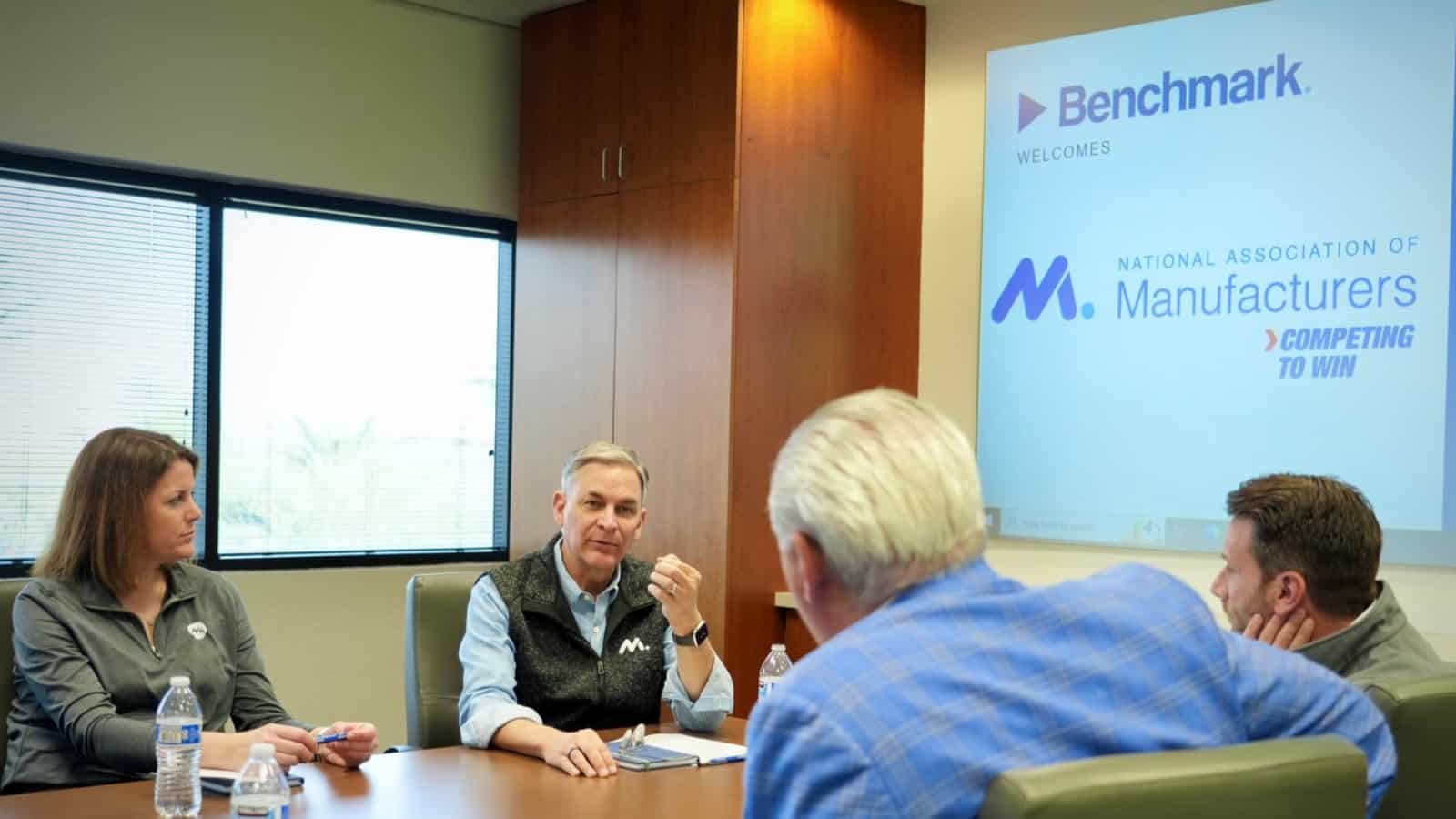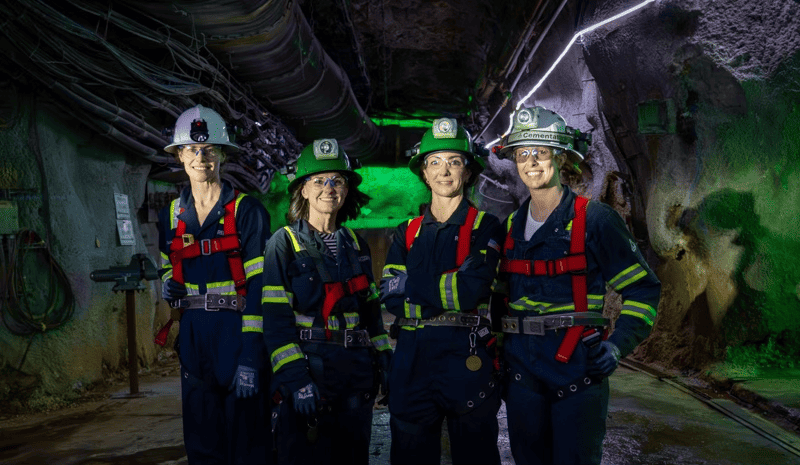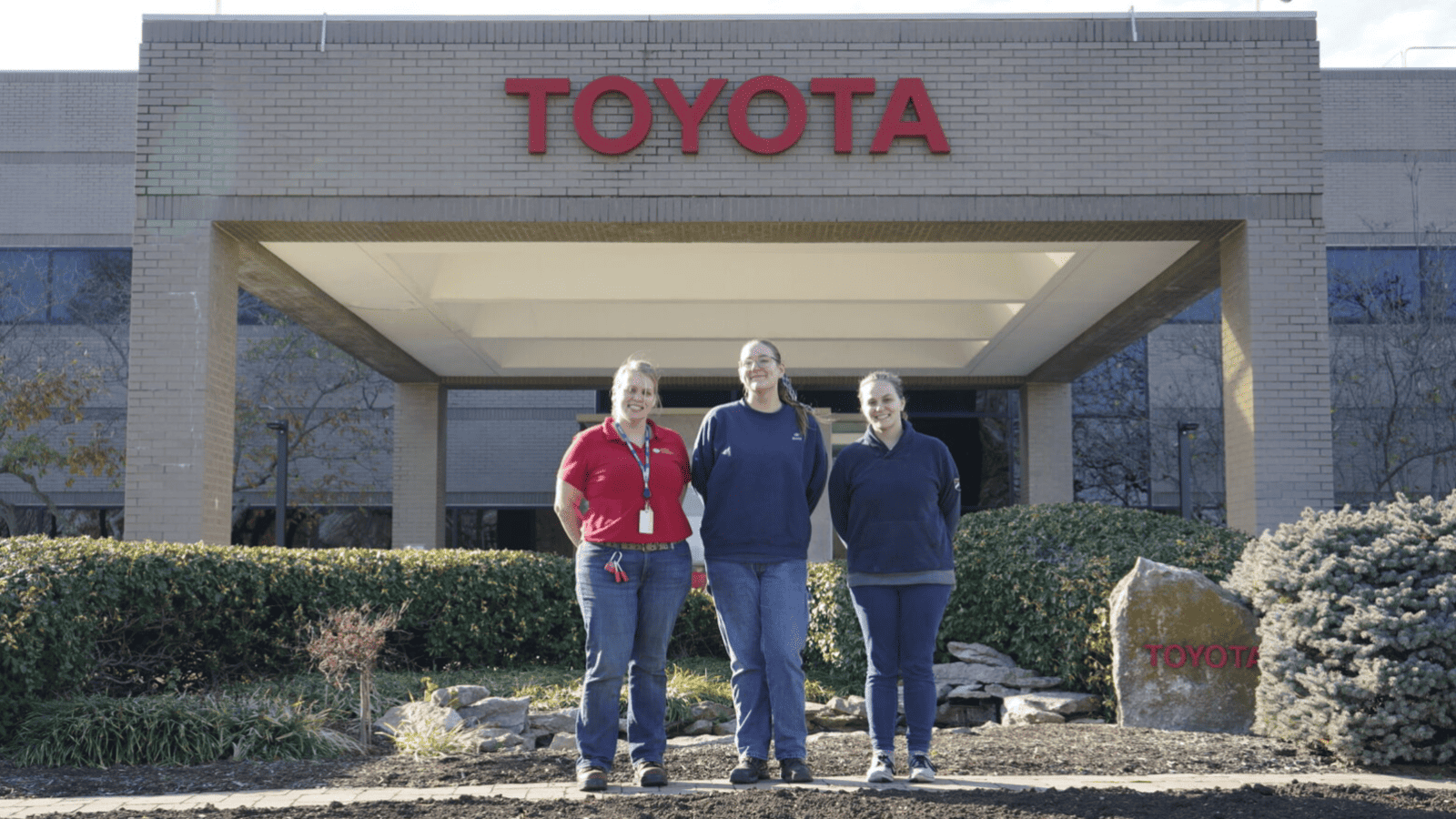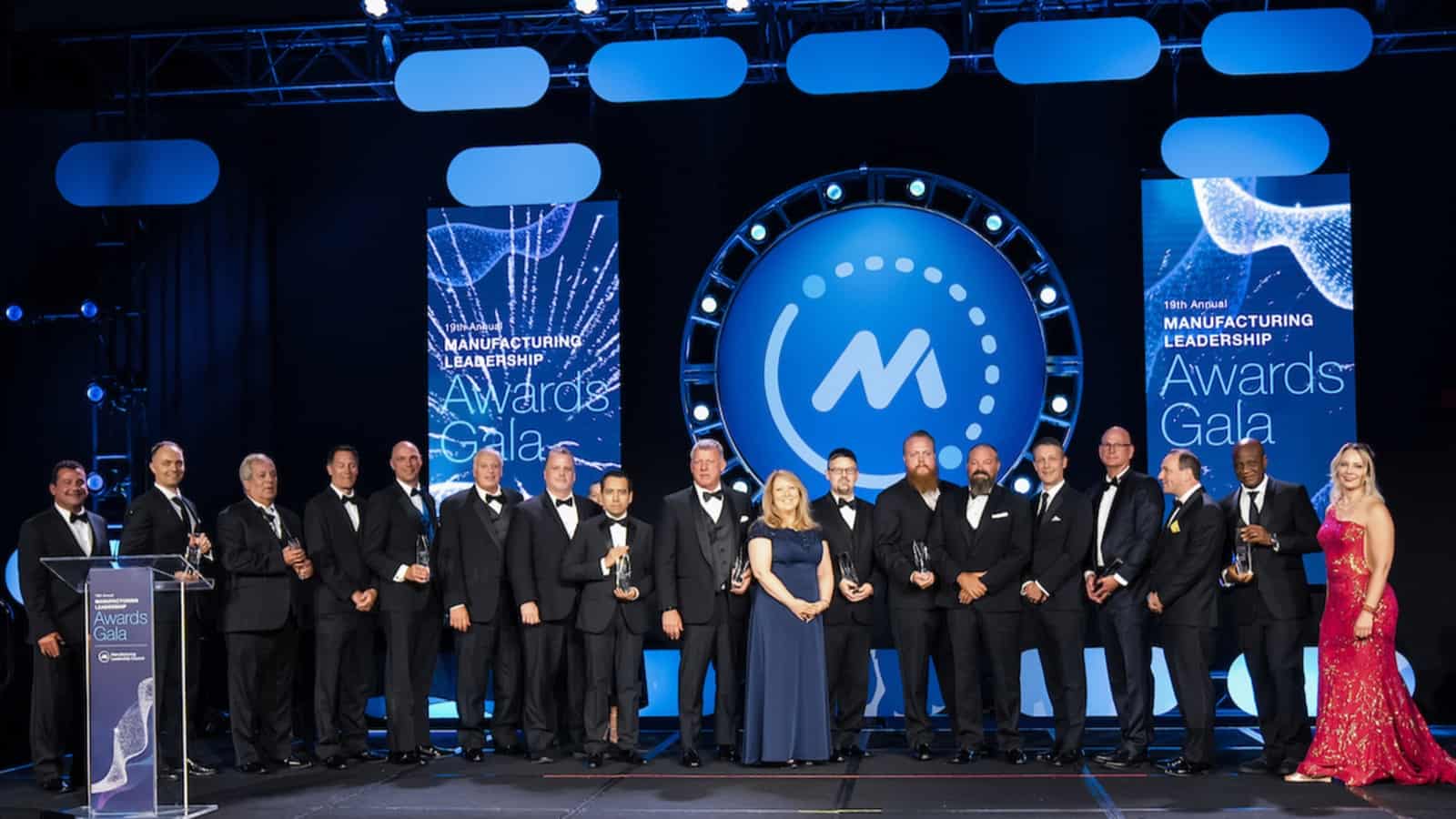Arizona: Manufacturing’s Crossroads

In the heat of Arizona’s “Silicon Desert” and surrounding communities, the future of America’s global competitiveness and climate goals aren’t just being forged—they also hang in the balance.
Last week for the first time in 2024, the NAM brought its Competing to Win Tour to Arizona, and that stark contrast between the status quo and the probable future was on display in Phoenix at global semiconductor equipment manufacturer Benchmark and small manufacturer Valley Forge & Bolt and at Resolution Copper in Superior.
- NAM President and CEO Jay Timmons, Manufacturing Institute President and Executive Director Carolyn Lee—who leads the NAM’s 501(c)3 workforce development and education affiliate—and Arizona Chamber of Commerce & Industry President and CEO Danny Seiden met with local manufacturers to gain their perspective and insights.
Why it matters: The Biden administration and Congress have secured key measures to bolster manufacturing in the U.S., including the NAM-championed CHIPS and Science Act and tax credits in the Inflation Reduction Act to manufacturers investing in advanced production and energy projects. But raw material, workforce and tax and regulatory policy challenges threaten to undermine policy aspirations.
Silicon Desert expansion: With the CHIPS and Science Act poised to transform the sector, Benchmark President and CEO Jeff Benck and Executive Vice President and Chief Operating Officer Dave Valkanoff led the tour of their state-of-the-art Phoenix facility.
- In a good spot: Benchmark is well-positioned for the coming growth in semiconductor equipment demand. It is focused on securing its workforce and navigating a complex regulatory landscape to maximize the opportunity.
- Workforce woes: Even with the NAM and the MI’s Benchmark-supported Creators Wanted campaign boosting the industry’s image and the MI’s FAME initiative training thousands of technicians, finding skilled labor remains the top challenge. Benchmark advances earn-and-learn programs and partnerships with Arizona State University and community colleges to help fill the pipeline, actions that, according to Lee, “can help change the game.”
- Red tape delays: Regulatory hurdles pose obstacles. Benchmark seeks streamlined permitting and sensible rules to maintain their global edge.
- Bullish outlook: Benck is optimistic about the future of U.S. manufacturing and semiconductor demand. Investments in people and technology position the company well to deliver the next generation of innovation.

Taxes and immigration: The NAM’s return visit to Valley Forge & Bolt, after a stop last year with Sen. Kyrsten Sinema (I-AZ), shone a spotlight on the real-world impact of stalled tax policy and the urgent need for reform.
- Valley Forge & Bolt saw record sales in 2023 thanks to 2017 tax reforms boosting its equipment upgrades. Now, with provisions like full capital investment expensing stalled in Congress, orders have slowed.
- CEO Michele Clarke and COO Bret Halley made the case for R&D expensing, interest deductibility and a return to full capital investment expensing. Without these, they said, job growth and America’s manufacturing competitive edge are at risk.
- Skilled workers needed: Despite its success, Valley Forge says finding skilled workers is a constant struggle. Immigration reform is a must to secure the right talent pipeline, said Clarke. “Did you notice our engineers? Most of them are under 30 because we’re snatching them right out of college,” added Clarke. “The engineering talent in this country is dwindling, and we’re not authorizing enough green cards. I, myself, was a green card holder before I became a citizen.”

Policy roadblocks: The NAM’s visit to Rio Tinto’s Resolution Copper site highlighted the urgency of permitting reform in the face of critical mineral needs.
- Copper’s critical role: Copper is essential for clean energy. Electric vehicles, solar power grids and wind turbines all demand huge quantities. Yet, the U.S. remains heavily reliant on imported copper, jeopardizing progress.
- Massive potential: The domestic solution lies within the stalled Resolution Copper mine. With its potential to supply 25% of U.S. copper demand, it’s poised to be a key piece of the puzzle.
- Project in limbo: Despite a 350-strong workforce modernizing and maintaining the mine, permitting delays stifle the project’s full impact.
- Sustainable practices: “Resolution Copper is the future of eco-conscious mining,” said NAM Managing Vice President of Brand Strategy Chrys Kefalas, who toured the site. “Their team innovates sustainable practices, leads in water conservation and even supplies 7 billion gallons of water to Arizona farms. And what is more, it isn’t just the facts of the matter or what you saw that drives this point home, but the people who have worked on the site for years make all that clear with the pride they have about the project and their determination to see Resolution Copper through to making lives better for everyone.”
- Jobs and growth: Led by President and General Manager Vicky Peacey, the project promises to contribute $1 billion annually to the economy and more than 1,500 Arizona jobs. “This is about people, jobs and supply chains; and it’s also about realizing clean energy ambitions at the speed and scale that climate goals demand,” said Kefalas.

The bottom line: “The future of U.S. manufacturing might hinge on these contrasting stories. Are we a nation that champions innovation, attracts and keeps the brightest here, supports our manufacturers and tackles climate goals with homegrown solutions, or one that stalls progress in its own backyard,” said Timmons.
- “Arizona is at the epicenter of American manufacturing’s next chapter, and with smart policies and fewer unforced errors at the federal level, we can clear the runway for growth,” added Seiden.
GlobalFoundries to Get $1.5 Billion in CHIPS Funding

Semiconductor maker GlobalFoundries Inc. will be the first recipient of funding under the NAM-supported 2022 CHIPS and Science Act, CNBC reports.
What’s going on: “The U.S. government is awarding $1.5 billion to GlobalFoundries to subsidize semiconductor production, the first major award from a $39 billion fund approved by Congress in 2022 to bolster domestic chip production.”
- The Malta, New York–based GlobalFoundries—the largest U.S. manufacturer of customized semiconductors and the world’s third-biggest chipmaker—plans to use the funds to build a new chip-production facility in its hometown and expand existing facilities there and in Burlington, Vermont.
- The Malta facility will manufacture high-value semiconductors not currently produced in the U.S., Commerce Secretary Gina Raimondo said.
- In addition to the grant, the federal government is also offering GlobalFoundries $1.6 billion in loans.
Why it’s important: “The chips that GlobalFoundries will make in these new facilities are essential chips to our national security,” Raimondo said on Sunday, adding that the “agency is in active talks with numerous applicants and expects to make several announcements by the end of March.”
- In January, Commerce announced it was awarding defense contractor BAE Systems $35 million under the CHIPS Act.
Our role: The NAM—which helped secure several manufacturing priorities in the final CHIPS Act legislation—welcomed the news.
- “Congratulations to [GlobalFoundries]!” the NAM wrote in a social post Monday. “The NAM-championed CHIPS and Science Act is strengthening manufacturing in the U.S. We will continue to work with Congress and the White House to enact permitting reforms that will help speed the construction of these vital projects.”
ICYMI: NAM Opposes Biden Administration’s Proposal to Undermine Manufacturers’ IP Rights
Washington, D.C. – Following the National Association of Manufacturers’ submission of comments opposing the Biden administration’s proposal that would allow the government to march in and seize the rights to groundbreaking innovations developed by manufacturers, NAM Vice President of Domestic Policy Charles Crain released the following statement:
“Undermining America’s world-leading patent system is a recipe for reduced innovation and significant economic damage, with a disproportionate impact on small manufacturers. The administration’s march-in proposal would raise the spectre of government price controls on a wide range of technologies—fundamentally reshaping how life-changing innovation is developed, financed and commercialized in the United States. The administration must affirmatively and unequivocally withdraw this radical and flawed proposal.”
The NAM’s comments on the proposal are available here. Key excerpts from the comments are below:
- The proposal contemplates an expansion of the Bayh-Dole Act’s march-in provision, which has never previously been used during the 44 years since the law’s enactment. This unlawful expansion of a 44-year-old statutory provision would prompt the government to exercise march-in rights to force patent licenses to private-sector inventions that are derived at least in part from federal funding. This price control measure would impact innovative companies of all kinds across the manufacturing sector.
- Undermining manufacturers’ IP rights would have sweeping ramifications for innovation in the United States and America’s world-leading innovation economy. In particular, start-ups and small businesses would bear the brunt of the drastic changes proposed by the administration, as the spectre of government march-in would disincentivize early-stage entrepreneurship and dissuade much-needed capital formation from outside investors.
- If the administration moves forward with the proposal, the unprecedented expansion and use of the Bayh-Dole Act’s march-in provision would impede R&D, investment and the commercialization of innovative technologies. It would cause significant market uncertainty as to current and future patent licenses that are derived in any part from federal funds—directly contradicting the intent and purpose of Bayh-Dole. And it would hinder industry collaborations with research universities and laboratories across the country, stymieing manufacturers’ efforts to develop the products and technologies of the future and bring them to the public.
- Courts have found that an agency violates the major questions doctrine on matters of significant economic importance when the agency cannot “point to clear congressional authorization for the power it claims.” The government’s ability to seize private-sector IP is undoubtedly a topic of vast economic and political significance; as discussed, America’s robust patent system lies at the heart of the innovation economy in the United States—and the proposal would threaten the financing of that innovation ecosystem and the economic viability of many of its key participants (including start-ups, entrepreneurs, small and medium-sized businesses, universities and more). The effects of the proposal would be felt in every state and every congressional district. Yet, the proposal cannot point to “clear congressional authorization” for including a price consideration in the government’s march-in analysis because it does not exist; as explained above, price is wholly absent from the Bayh-Dole Act’s text. More broadly, the act was enacted to support public–private partnerships and bolster the innovation economy in the United States—yet, the proposal would undermine and endanger American innovation. It is unlikely that Congress, in passing the Bayh-Dole Act, “could reasonably be understood to have granted” the administration the power to vitiate the primary goal of the act itself.
- The NAM respectfully encourages the administration to provide certainty to manufacturers and other stakeholders in the innovation economy by affirmatively and unequivocally withdrawing the proposal and making clear that the administration will not implement any of its recommendations. Abandoning and disclaiming the proposal’s attempts to impose price controls and undermine the Bayh-Dole Act will ensure that manufacturers in the United States can continue to lead the world in R&D and innovation—and continue to create and support well-paying jobs vital to the success of the U.S. economy.
-NAM-
The National Association of Manufacturers is the largest manufacturing association in the United States, representing small and large manufacturers in every industrial sector and in all 50 states. Manufacturing employs nearly 13 million men and women, contributes $2.85 trillion to the U.S. economy annually and accounts for 53% of private-sector research and development. The NAM is the powerful voice of the manufacturing community and the leading advocate for a policy agenda that helps manufacturers compete in the global economy and create jobs across the United States. For more information about the NAM or to follow us on Twitter and Facebook, please visit www.nam.org.
Three Sisters Build Manufacturing Careers Together

For three sisters in Kentucky, manufacturing is a family affair.
Emily Bastin, Heather Craven and Hannah Geneve are all working in maintenance roles supporting various shops at Toyota Motor Manufacturing Kentucky. Growing up, they had disparate interests—while Emily had taken robotics classes in middle school and Heather had always enjoyed working with her hands, Hannah switched to manufacturing only after working in customer service. Today, all three of them are building careers in manufacturing together.
How they got here: Emily, Heather and Hannah found their way into manufacturing through FAME—an initiative for current and aspiring manufacturing workers that was founded by Toyota in 2010 and is operated today by the Manufacturing Institute, the NAM’s workforce development and education affiliate.
- The FAME Advanced Manufacturing Technician program offers on-the-job training and classroom education that combine technical training with professional practices and lean learnings to create world-class technicians. The two-year AMT program leads to an associate degree and the FAME certificate.
- “They came to my school—the AMT program—and I was like, you know, let’s give this a shot,” said Emily. “I didn’t realize I would have that kind of potential. This was cool stuff.”
The family business: Emily was the first of the three sisters to graduate from FAME, and she has been helping her sisters as they work their way through the program. Both Hannah and Heather are enrolled in FAME while working at Toyota, and they expect to graduate in May 2025.
- “We’re all working in the same plant, and if they need anything from me, I’m there to be supportive,” said Emily.
- “With schoolwork, I try to help Heather, and she tries to help me,” said Hannah. “We all help where we can.”
- “It’s nice to have that sister love to lean on,” said Heather. “They understand the frustration of school and work, and it’s been a pleasure to work with them.”
Opportunities abound: The sisters advise others who might not have considered manufacturing as a career—especially women—to give the industry a second look, emphasizing the sheer diversity of jobs on offer.
- “Working in manufacturing doesn’t necessarily mean you’re working on a factory floor,” said Hannah. “There’s an administrative side, an HR side—there’s a lot more to manufacturing than people expect.”
- “I do see us being examples for women who might not normally see themselves in the field,” said Heather. “You want to see women come in and say, hey, I did it, and you can, too. It’s nice to see yourself reflected back.”
The community: It’s not just their family ties that keep the sisters in manufacturing. All three sisters have high praise for their fellow students and colleagues, and for the supportive culture they’ve encountered at Toyota.
- “The mentorship I got helped me gain my confidence while I was learning,” said Emily. “And even now, the teamwork that goes into everything, every day—it’s been a nice surprise.”
- “Everyone has been super nice, super helpful and super welcoming,” said Hannah. “When you start out, it can seem intimidating, but everyone’s willing to help you out. They really want you to succeed.”
The last word: “It’s nice to feel like you’re a part of that network—that family,” said Heather.
The MI’s 35×30 campaign aims to increase the share of women in manufacturing to 35% by 2030 and spotlights outstanding women in the industry like these sisters. To learn more about Women MAKE America and explore its many opportunities, including its new mentorship program, go here.
The Federation for Advanced Manufacturing Education provides global-best workforce development through strong technical training, integration of manufacturing core competencies, intensive professional practices and intentional hands-on experience to build the future of the modern manufacturing industry. Learn more here.
Jennifer Abril to Chair NAM’s Council of Manufacturing Associations
Washington, D.C. – The National Association of Manufacturers announced new 2024 leadership for its Council of Manufacturing Associations at the CMA 2024 Winter Leadership Conference. Jennifer Abril, president and CEO of the Society of Chemical Manufacturers & Affiliates, will serve as chair, and Alison Bodor, president and CEO of the American Frozen Food Institute, will serve as vice chair.
“The CMA’s mission is to demonstrate the vital importance of manufacturing to the American economy,” said Abril. “In collaboration with the NAM, the CMA’s member associations will advocate for job creation, investment and innovation in American manufacturing. The strength and weight of the CMA’s voice is unparalleled, and I am honored to serve as the champion for our collective industries’ resilience and growth.”
Made up of more than 200 industry-specific manufacturing associations representing 130,000 companies worldwide, the CMA creates powerful partnerships across the industry, working with the NAM to unite the manufacturing association community, and ultimately the broader business community, around strategies for increased manufacturing job creation, investment and innovation in America.
“Jennifer and Alison have been instrumental to the success of the CMA, particularly in pushing back against an onslaught of unsustainable regulations that would crush President Biden’s goal of growing manufacturing in the United States,” said NAM President and CEO Jay Timmons. “We are confident that they will work in their expanded roles to amplify manufacturers’ voices and further position our industry for global leadership.”
Abril has led SOCMA since 2016. Prior to that, she served as the president of the International Fragrance Association, North America and held leadership positions at the American Chemistry Council. She previously served as CMA vice chair.
Newly appointed 2024 CMA board members include the following:
- Stephen Kaminski, president and CEO, National Propane Gas Association
- Kelly Mariotti, president and CEO, Association of Home Appliance Manufacturers
- Ellen Thorp, executive director, EPDM Roofing Association
-NAM-
The National Association of Manufacturers is the largest manufacturing association in the United States, representing small and large manufacturers in every industrial sector and in all 50 states. Manufacturing employs nearly 13 million men and women, contributes $2.85 trillion to the U.S. economy annually and accounts for 53% of private-sector research and development. The NAM is the powerful voice of the manufacturing community and the leading advocate for a policy agenda that helps manufacturers compete in the global economy and create jobs across the United States. For more information about the NAM or to follow us on Twitter and Facebook, please visit www.nam.org
Manufacturers Launch Seven-Figure Ad Campaign Opposing Biden Administration’s March-In Proposal
Washington, D.C. – The National Association of Manufacturers has launched a seven-figure television and digital advertising campaign opposing the Biden Administration’s new proposal that would allow the government to march in and seize the rights to groundbreaking innovations developed by manufacturers.
“This radical new proposal is a major threat to manufacturers in America and counter to the president’s goals of growing the sector,” said NAM President and CEO Jay Timmons. “Empowering the government to march in and seize the rights to private-sector patents and technologies threatens American innovation and R&D, putting millions of well-paying manufacturing jobs at risk. Policymakers must protect manufacturers’ intellectual property rights and stop this government overreach.”
To view the latest television ad, click here.
-NAM-
The National Association of Manufacturers is the largest manufacturing association in the United States, representing small and large manufacturers in every industrial sector and in all 50 states. Manufacturing employs nearly 13 million men and women, contributes $2.75 trillion to the U.S. economy annually and accounts for 53% of private-sector research and development. The NAM is the powerful voice of the manufacturing community and the leading advocate for a policy agenda that helps manufacturers compete in the global economy and create jobs across the United States. For more information about the NAM or to follow us on Twitter and Facebook, please visit www.nam.org.
New Study: “Right-to-Repair” Stifles Innovation, Threatens Consumer Safety
Washington, D.C. – The National Association of Manufacturers released a new study, “The Economic Downsides of Right-to-Repair,” which highlights the cost to the environment, consumer safety and manufacturing innovation of providing unfettered access to complex software and components in manufactured goods. The study analyzes the wide range of unintended and potentially harmful consequences of “right-to-repair” legislation.
The study finds that instituting “right-to-repair” polices directly counteracts many federal laws put in place to protect both manufactures and consumers. The study states that, “bypassing the proper channels for repair will come at a steep cost to quality, performance, consumer safety, the environment and the broader U.S. economy.”
Notably, “right-to-repair” policies could seriously disrupt original equipment manufacturers’ supply chains, which would leave many consumers—especially in rural communities—without a reliable and efficient place to get a repair. “This could increase costs for customers significantly, as delays in placing equipment back in service directly affect a business’s bottom line,” the study warns. The study further highlights an Environmental Protection Agency estimate that more than 500,000 tons of excess emissions have entered the atmosphere since 2009 due to operators disabling or modifying emission controls in vehicles across multiple industries.
“For decades, manufacturing innovation has created new products and technologies that improve modern life,” said NAM Managing Vice President of Policy Chris Netram. “Unfortunately, so called ‘right-to-repair’ policies would threaten these programs, resulting in harm to the environment and putting American’s data and safety at risk.”
Background: In 2021, President Joe Biden signed an executive order encouraging the Federal Trade Commission to enact policies limiting OEMs’ ability to prevent nonauthorized entities from performing certain repairs. The NAM submitted comments to the FTC, calling “right-to-repair” legislation a, “solution in search of a problem.” As of 2023, New York, Minnesota and Colorado have enacted “right-to-repair” legislation, and 23 other states have also considered legislation that would force manufacturers to provide direct access to replacement parts, grant unfettered access to the central processor and further limit their ability to constrain what consumers can do with their product.
-NAM-
The National Association of Manufacturers is the largest manufacturing association in the United States, representing small and large manufacturers in every industrial sector and in all 50 states. Manufacturing employs nearly 13 million men and women, contributes $2.91 trillion to the U.S. economy annually and accounts for 53% of private-sector research and development. The NAM is the powerful voice of the manufacturing community and the leading advocate for a policy agenda that helps manufacturers compete in the global economy and create jobs across the United States. For more information about the NAM or to follow us on Twitter and Facebook, please visit www.nam.org.
NAM Study: U.S. Pharmaceutical Manufacturing Strength Requires Commitment to R&D, Innovative Regulatory Environment
Washington, D.C. – The National Association of Manufacturers released a new study, “Creating Cures, Saving Lives,” which demonstrates the urgency of strengthening U.S. pharmaceutical manufacturing amid policy threats to the sector’s innovative, global leadership.
“Creating Cures, Saving Lives” analyzes the sector’s contributions to the broader economy and its commitment to R&D that drives the development of lifesaving treatments, such as advancements in therapeutics that fight cancer. The study further examines the ways that federal price controls on the sector, such as those contained in the Inflation Reduction Act, could jeopardize these treatments. The study comes at a critical time, as the Centers for Medicare & Medicaid Services recently announced the first tranche of treatments that will be subject to price controls.
“Pharmaceutical manufacturers are a major contributor to the U.S. economy, employ millions of Americans and drive innovation. The industry’s investments in R&D have led to lifesaving treatments and therapies that have improved the quality of life for all Americans,” said NAM Chief Economist Chad Moutray. “This study explores the negative implications of price control policies on pharmaceutical leadership, putting American jobs and innovation in the health care system at risk.”
“Creating Cures, Saving Lives” includes seven key findings on the importance of the pharmaceutical and medical manufacturing industry and the implications of price controls on the sector:
- The pharmaceutical manufacturing industry is a major contributor to the U.S. economy, and its impact is growing.
- The industry accounted for $355 billion in value-added output to the U.S. economy in 2021. The direct contribution from the industry of $192 billion is up 24% from just two years ago. The pharmaceutical sector was already an economically vital sector before the pandemic, and it has become increasingly more important in its aftermath.
- The pharmaceutical manufacturing industry fuels other sectors of the economy, supporting nearly 1.5 million jobs in America.
- The industry directly employs an estimated 291,000 workers in the United States, an increase of nearly 9% in the past 24 months. One job in the pharmaceutical manufacturing industry helps support 4.1 other jobs in the overall workforce.
- Industry employees are highly productive.
- Industry employees produce $1.2 million in output per employee. This is nearly six times more than the U.S. economy’s average output per employee ($208,084).
- A successful pharmaceutical ecosystem requires strong private-sector investment.
- The pharmaceutical industry invests 16.6% of its sales back into R&D. Indeed, the U.S. pharmaceutical industry invests nearly 3.5 times more in R&D as a percentage of sales than the average U.S. industry.
- The pharmaceutical manufacturing industry pays high wages and benefits to American workers.
- Annual average labor income per worker in the pharmaceutical manufacturing industry is more than $184,000. This figure is higher than some of the highest-paying industries in the country.
- The industry creates valuable STEM jobs.
- While roughly 6.6% of the U.S. workforce has a STEM occupation, some 25% of all jobs in pharmaceutical and medicine manufacturing are STEM-related. The pharmaceutical manufacturing sector employs more than four times the percentage of STEM workers employed in the overall workforce.
- Price control policies, like those in the IRA, may hurt U.S. pharmaceutical leadership.
- Price controls may deter advancements in health care by reducing investments in R&D, negatively impacting the nation’s economic prosperity.
-NAM-
The National Association of Manufacturers is the largest manufacturing association in the United States, representing small and large manufacturers in every industrial sector and in all 50 states. Manufacturing employs nearly 13 million men and women, contributes $2.91 trillion to the U.S. economy annually and accounts for 55% of private-sector research and development. The NAM is the powerful voice of the manufacturing community and the leading advocate for a policy agenda that helps manufacturers compete in the global economy and create jobs across the United States. For more information about the NAM or to follow us on Twitter and Facebook, please visit www.nam.org.
NAM Sets the Policy Agenda for Manufacturing in the U.S.

The NAM is the voice of the manufacturing industry in the United States, speaking out on issues that matter to the men and women who make things in America. As times change, new issues arise, and to stay up to date with the needs of its members, the NAM updates its policy position documents accordingly.
That process—now underway for 2023—takes place with our member companies every four years under the guidance of the NAM Board of Directors. Here’s what you need to know.
The timeline: Proposed changes have been distributed from the NAM policy teams to the respective policy committees, and members have until Oct. 31 to provide their feedback.
- Shortly after Oct. 31, NAM policy committees will convene to consider the proposed changes and any subsequent suggested edits. If needed, working groups will be organized to consider new or revised language on specific issues.
The result: The NAM policy committees will recommend new policy language to the NAM Board based on their engagement with member companies.
- At the February 2024 board meeting, the NAM Board will finalize and approve the policy positions that will guide the NAM for the next four years.
How to participate: Member companies can choose which policy committees they serve on, so as the policy update process commences, companies should contact their membership directors to ensure they are aware of the various policies and committees that may be most important to their own businesses.
The last word: “Our member companies are at the center of this policy update process,” said NAM Managing Vice President of Policy Chris Netram. “The NAM fights every day for a policy agenda that supports manufacturing growth, and this is a critical opportunity for manufacturers across the country to have their say on the issues that matter to them.”
Manufacturing Leadership Awards Kick Off 20th Season

For two decades, the Manufacturing Leadership Awards have recognized outstanding manufacturing companies and their leaders for their groundbreaking use of advanced manufacturing technology. What started out in 2005 as a modest 50-person gathering in New Orleans has evolved into one of the industry’s most exciting celebrations.
This past June, the Manufacturing Leadership Awards Gala honored an impressive 163 projects and leaders, in front of an electrified crowd of 450 guests. The program’s growth is a testament to the momentum of Manufacturing 4.0 technologies and their success in creating performance improvements and boosting competitiveness.
With more manufacturers adopting digital and data-driven methods every day, there is still much to celebrate. The program’s 20th season is now open for nominations, with expectations running high for another amazing show in 2024.
A proud heritage: Past winners from the Manufacturing Leadership Awards include companies and leaders from nearly every industry, from 10-person shops to multinational enterprises, located all around the world.
- Each entry is reviewed by a judging panel made up of industry experts with extensive experience in technology transformation. The top-scoring projects are selected as category finalists, and the category winners are revealed at the awards gala.
- Finalists and winners report that the awards have helped them gain new customers, boosted employee morale and team camaraderie and encouraged their executive leadership to continue investing in digital technology initiatives.
- Since the program’s inception, more than 1,000 leaders and projects have been honored for their achievements.
A wide range of candidates: The awards program welcomes submissions from small and medium-sized enterprises, as judges look for the overall level of impact that projects have had on a company’s operations—not the dollar amount of their investments.
- If technology has measurably helped a company improve its operational performance, upskill employees or enter new business markets, those projects are excellent candidates for award nominations.
The categories: Over the years, the awards have encompassed an evolving list of categories, currently at nine for projects and two for individuals.
- Project categories include AI and Machine Learning, Collaborative Ecosystems, Digital Network Connectivity, Digital Supply Chains, Engineering and Production Leadership, Enterprise Integration and Technology, Operational Excellence, Sustainability and the Circular Economy, and Transformational Business Cultures.
- Individual categories include Digital Transformation Leadership, for established manufacturing operations executives who lead Manufacturing 4.0 initiatives, and Next-Generation Leadership, for up-and-coming operations leaders aged 30 or younger.
Get involved: All manufacturers in any location and of any organizational size are eligible and encouraged to apply. Program details, rules and instructions for how to submit a nomination are available on the MLC website. Entries are due Jan. 17, 2024.
